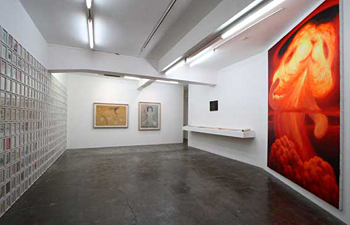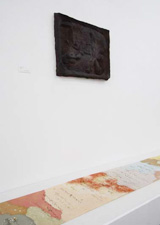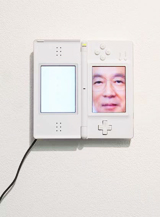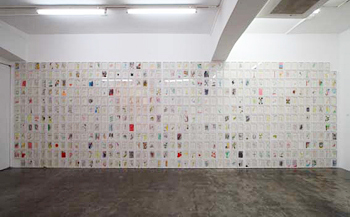 |
|
 |
Left: "I'm IWAKI of Mizuma Art Gallery!!", 2008
Installation view, Mizuma Art Gallery
Right Top: Doha, 2008, bronze, 39.5 x 45.7 x 4.5 cm
Bronze created by Akihiko Nagai
Right Bottom: Japanese Language, 2008, Japanese paper, gold leaf, silver leaf, sumi ink, 28 x 800 cm
Scroll created by Shuntaro Kubo and Rie Sakiya
Calligraphy by Yukie Nago |
All around us the world seems to tremble under the weight of a multitude of frailties. Japan keeps changing heads of state, Lehman Brothers has filed for bankruptcy, bombs continue to explode in marketplaces and the news media keep reminding us of imminent ecological collapse. Amid all of this the contemporary art market, guided by a burgeoning global art fair culture, apparently continues to flourish. Commercial galleries today open branches around the world like fast food restaurants.
It was with such thoughts in mind that I went to see Makoto Aida's one-person exhibition at the Mizuma Gallery in Tokyo. In the current market climate, the Mizuma Gallery has grown too, recently opening a space in Beijing. Aida's exhibition seemed to reflect on all of this subliminally, providing an opportunity to ask oneself the largely forgotten question: "What kinds of zones and spaces can art create today?"
The exhibition was in many ways a "Best Of" compilation from the various strands of Aida's oeuvre. There were technically brilliant paintings, ink brush works, expressionistic oil paintings, a video, a sculpture, and a collaboration with students. One of the strengths of his work has been this sense of diversity of media and methods through which he isolates and spears various issues.
Aida's work can be categorized into three related areas: questions of Japanese politics and power, questions of Japanese aesthetics and beauty, and questions of relationships with the "West". A poster work urged all Westerners to honorably commit ritual suicide; torn pages from Kant's Critique of Judgement were used for abstract drawings; a Nintendo Gameboy served as a platform for an ever-morphing series of faces of recent Japanese prime ministers; a roughly sculpted relief depicted the so-called "Agony of Doha," the soccer game in 1993 when Japan was knocked out of the World Cup qualifiers; two new "Dog" series paintings showed slender young girls without arms or legs against serene, melancholic backgrounds; a huge penis/mushroom-cloud shaped manga character painted in oil rose upwards with the face of a troubled rabbit. Aida is clearly someone with many ideas; his approach is one of crafting each idea into a form without privileging a sense of an "overall practice." In this he seems to implicitly reject the orthodox modern idea of the artist as a practitioner embedded in a linear historical process. Like that of the late German artist Martin Kippenberger, Aida's work seems to multiply an already fragmented self in bursts of tangled critique and playfulness. It is difficult to see his works as a slowly developing series of artistic statements. Rather, he seems to try to remain deeply engaged with the social and political contexts in which he finds himself, seeking there the literary and visual clues which he brings to his work.
At a time when Japanese contemporary art is effectively neutralized in a global market scenario, Aida's production resolutely refuses to be just art and thus to be circulated only on an art circuit. His works seem to always retain a sense of the documentary, of history painting and of what the French painter Gustave Courbet (an artist I relate to Aida) called "the regime of liberty."
 |
|
 |
The Land of Games, 2008, Nintendo DS
Programming by Keisuke Tanaka |
|
Critique of Critique of Judgement, 2008, paperback book, water based pen, 14.5 x 10.3 cm each (574 pages total) |
|
|
|
 |
All photos by Kei Miyajima
© Makoto Aida
Courtesy Mizuma Art Gallery |
|
Left: All Westerners should commit harakiri to take their responsibilities!! (from the series "Minna to Issho"), 2008, imitation Japanese vellum, magic marker, acrylic, 109.1 x 78.8 cm
Right: Maybe man is a vainly thinking mold (from the series "Minna to Issho"), 2008, imitation Japanese vellum, magic marker, acrylic, 109.1 x 78.8 cm |
|
|